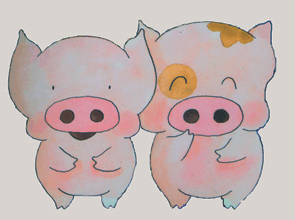McMug and Friends to debut on iTVFirst cartoon made solely in Hong Kongby Wayne Leung Hong Kong people will soon have a “home-made” cartoon. McMug, a well-known original Hong Kong cartoon character, will appear in a cartoon series on iTV early this year. People in Hong Kong, especially children and teenagers, have long been fascinated by cartoon characters such as Doraemon and Chibi Maruko. However, they are actually “foreigners” in the sense that they are produced in Japan. McMug, the most popular pig in Hong Kong, together with his animal friends, will become the first purely “made-in-Hong Kong” cartoon characters.
“Creating cartoons is always the goal of comic book makers,” said Mr. Eric Tse, McMug’s publisher. According to Mr. Tse, the McMug cartoon series will contain thirteen 30-minute episodes. The first one is expected to be shown on early 1998, after the introduction of iTV. Some wonder why iTV was chosen as the broadcast outlet instead of some other television operation that has more experience in broadcasting cartoons. “We cooperated with iTV because they were so supportive to the project and they actively contacted us,” explained Mr. Tse. Mr. Tse and his team are also attracted by the way iTV operates. “In iTV, there is no time limitation. An episode is put on the server for several months for showing. This allows us to spend around two to three months to work on one episode,” said he. Although Hong Kong witnesses the production of several television cartoons in the past, they were not purely “made-in-Hong Kong”. Some processes were finished in mainland China or Taiwan. Thus, strictly speaking, McMug will be the first locally produced cartoon. The main difficulty Mr. Tse and his team encountered is the lack of experienced professionals. “Since there has been no mass production of cartoons in Hong Kong before, not enough professionals are available. Although some people have worked for foreign cartoon companies, they were just partially involved. They are not very familiar with the overall production,” said Mr. Tse. Though there is a lack of experience, Mr. Tse said technical problems did not create many obstacles. “People in Hong Kong are familiar with computers. With the help of computers, many difficulties are being solved,” he said. He also finds there are many differences between producing comics and cartoons. “Comprehensive and careful planning is definitely required when producing cartoons. It is very expensive to produce an episode of cartoon. Careless mistakes are not allowed during production. They lead to a waste in capital,” he said. The channels also make a difference. Comics are just drawings, but cartoons involve both visual and audio parts. “More work is needed since sound also plays a vital part in cartoons. You have to think about the dubbing and sound effects so as to make the cartoon more interesting and appealing, explained Mr. Tse. To cover the high production cost, Mr. Tse said they have had to take overseas markets into consideration. “The content of cartoons should be more general instead of localized, as comics are. We cannot talk too much about local stuff. “The pace of the cartoon should also be controlled to match the tastes of the overall audience around the world,” said Mr. Tse. Although much has been done to develop markets around the world, there still has been no concrete move. “We have to wait to see the feedback of the cartoon after two or three episodes are shown,” said he. Meanwhile, Mr. Tse is optimistic about the development of local cartoons. “Institutions such as Hong Kong Polytechnic University and the technical institutes will arrange courses on this. “And as local cartoons become more popular, the problem of insufficient numbers of professionals will be solved,” said he. “Of course there will be difficulties encountered at the beginning. But in the long run, I do not think there will be big problems.” [Like a Bridge Over the University] |
